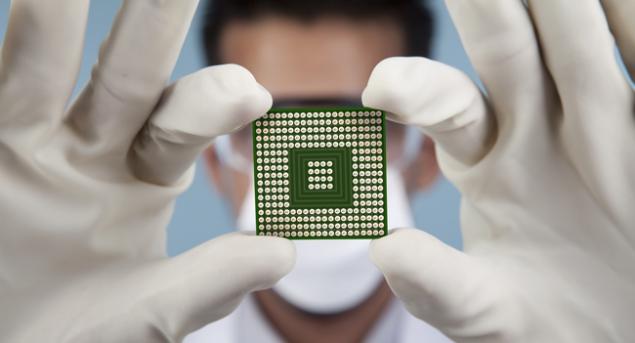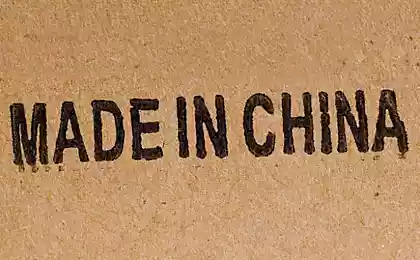1323
By 2019, two-thirds of smartphones will be developed by the suppliers of hardware platforms
Today, in some circles is considered good form to talk about the lack of innovation in the field of smart phones, as well as the huge number of secondary solutions. Regarding innovation can argue for a long time, but with item number two is hard to disagree. Go to the store and on the shelves of dozens of similar smartphones from local domestic brands. There are among them and virtually complete twins and almost identical pattern with minimal differences (e.g., one camera 3 M and the other - 5).
It is clear that our taryatsya megabreny mostly on the same factories, Chinese businessmen know how to build a domestic rare, they take [merchants] are used that give. It turns out that smartphones are alike as two drops of water. It's time to exclaim: "Do you want something dull Chinese - take Samsung, HTC or Nokia!». Yes, today the production of these and other firms stand out against products sold under our brands. Highlight it, as a rule, design, ergonomics, quality camera and software tokens, but in terms of iron at a comparable price inferior. (For details, eg, here ) average buyer in the meantime still believes in the power of the brand, thereby inexpensive products major manufacturers are still selling well, although "lokalschiki» gradually eat off their share.

Besides that some no uniqueness and convenience - perhaps the most powerful features of low-cost smartphones A-brands - over time, the risk of partial or completely disappear. This conclusion can be drawn from notes online DigiTimes - one of the most trusted sources of the Asian world of electronics, which refers to the study of the analytic office ABI Research.
In 2013, more than a third of smartphones sold in the world, based on the reference design, the proposed developers of chipsets. (In this case, 69 percent of these vehicles were worth less than $ 200.) That is, in Qualcomm, MediaTek, Spreadtrum and other companies make some basic options for smartphones on their platforms, which are then allowed to produce Chinese and Indian factories. Recently due to lack of engineering experience themselves nothing sensible can not do, and that option for them is great. Then these "clones" and can be sold under its own brand, but you can "Provisional Government" our merchants.
It would seem, what's wrong? And that's what. In large companies - developers smartphones (Samsung, HTC, LG, Nokia and so on) have a whole team of engineers responsible for the so-called yuzebiliti - a complex concept, implying that the device is convenient to use and it does not cause a sharp rejection. Meanwhile, Qualcomm, MediaTek, Spreadtrum and others like them, it seems all this is quite difficult - otherwise it would not have been on the market, for example, cheap 5, 5- and 6-inch smartphone with the power button on top.
So, it would seem, what side is the A-brands? B> The thing is that the process of "otedaniya 'local market share of A-brands rather tired and oppose small but defiant companies mastodons market nothing can not. That is gathered, for example, LG smartphone design for 100 bucks. She put a bunch of money in software, has developed a unique design, will select the correct body materials, provide no serious glitches even in the first firmware. And then it turns out that the budget is consumed by two-thirds, and in this unit have put puny processor, 3-inch screen with a low resolution and 512 MB of RAM. Analogues of the Russian brand / Chinese manufacturer will glitches, and less wear-resistant materials, and the camera is worse, but the 5-inch display and RAM gigabytes. As a result, buyers increasingly prefer "Russian Chinese».
All of this leads to the following: According to ABI Research company Nokia, Samsung, HTC, LG, Huawei and ZTE are very reluctantly, but still will ispolzovatreferensnye device design, the proposed developers of chipsets. The reasons are simple - the salvation of his position in the emerging markets by offering low-cost devices, which would have benefited from the figures for the price of similar smartphones own design.
The question is, how serious these manufacturers will take up dopilivanie reference design and the selection of the independent components. (Apparently, Qualcomm, MediaTek and Co. not only offer a basic smartphone with a description of its performance characteristics, but also to give advice - who to buy accessories.) Yes, Samsung, LG and other grandees candid crafts on the market do not appear - here as they say, the image is more expensive. But the desire to save money and compete with the Chinese in the lower segment, too, played a role. So, it may very well be that the characteristics of low-priced products of A-brands in the future will improve, but yuzebiliti deteriorated somewhat. Thus the design of such "non-native" smartphone from first-tier manufacturers are likely to retain the firm lines. Just remember that even Russian Highscreen (but not on the scale it does not even Samsung and ZTE) for the line of smartphones Zera developed a > a unique design that is not found in devices from Chinese brands. Plus finished mediatekovskuyu standard platform vpihnuv, for example, in a budget model Highscreen Zera F 1 GB of RAM instead of 512 MB. This suggests that the ability to dodge and something had finished his A-brands will also be, that's just as far as they will take advantage of it ...
In ABI Research predicts that by 2019 two three smartphones will be based on the reference design chipset developers. 23 percent of these vehicles will cost more than $ 200, the other - cheaper. At the same time emphasizes that model cost more than $ 400 for the most part will be developed from scratch by the companies of the first tier: allow the process of their creation chipmakers can not, because the output can not get something that expects to pay more than $ 400 per user.
Personally, I'm all this is not that frustrating, but does not cause much enthusiasm. Perhaps because I found a time when every gadget was a kind piece of engineering. Now it is the art turned into a conveyor, and in the foreseeable future will catch up to it yet and the main current "sculptors" in the world of electronics.
What do you think about this?
Source:
It is clear that our taryatsya megabreny mostly on the same factories, Chinese businessmen know how to build a domestic rare, they take [merchants] are used that give. It turns out that smartphones are alike as two drops of water. It's time to exclaim: "Do you want something dull Chinese - take Samsung, HTC or Nokia!». Yes, today the production of these and other firms stand out against products sold under our brands. Highlight it, as a rule, design, ergonomics, quality camera and software tokens, but in terms of iron at a comparable price inferior. (For details, eg, here ) average buyer in the meantime still believes in the power of the brand, thereby inexpensive products major manufacturers are still selling well, although "lokalschiki» gradually eat off their share.

Besides that some no uniqueness and convenience - perhaps the most powerful features of low-cost smartphones A-brands - over time, the risk of partial or completely disappear. This conclusion can be drawn from notes online DigiTimes - one of the most trusted sources of the Asian world of electronics, which refers to the study of the analytic office ABI Research.
In 2013, more than a third of smartphones sold in the world, based on the reference design, the proposed developers of chipsets. (In this case, 69 percent of these vehicles were worth less than $ 200.) That is, in Qualcomm, MediaTek, Spreadtrum and other companies make some basic options for smartphones on their platforms, which are then allowed to produce Chinese and Indian factories. Recently due to lack of engineering experience themselves nothing sensible can not do, and that option for them is great. Then these "clones" and can be sold under its own brand, but you can "Provisional Government" our merchants.
It would seem, what's wrong? And that's what. In large companies - developers smartphones (Samsung, HTC, LG, Nokia and so on) have a whole team of engineers responsible for the so-called yuzebiliti - a complex concept, implying that the device is convenient to use and it does not cause a sharp rejection. Meanwhile, Qualcomm, MediaTek, Spreadtrum and others like them, it seems all this is quite difficult - otherwise it would not have been on the market, for example, cheap 5, 5- and 6-inch smartphone with the power button on top.
So, it would seem, what side is the A-brands? B> The thing is that the process of "otedaniya 'local market share of A-brands rather tired and oppose small but defiant companies mastodons market nothing can not. That is gathered, for example, LG smartphone design for 100 bucks. She put a bunch of money in software, has developed a unique design, will select the correct body materials, provide no serious glitches even in the first firmware. And then it turns out that the budget is consumed by two-thirds, and in this unit have put puny processor, 3-inch screen with a low resolution and 512 MB of RAM. Analogues of the Russian brand / Chinese manufacturer will glitches, and less wear-resistant materials, and the camera is worse, but the 5-inch display and RAM gigabytes. As a result, buyers increasingly prefer "Russian Chinese».
All of this leads to the following: According to ABI Research company Nokia, Samsung, HTC, LG, Huawei and ZTE are very reluctantly, but still will ispolzovatreferensnye device design, the proposed developers of chipsets. The reasons are simple - the salvation of his position in the emerging markets by offering low-cost devices, which would have benefited from the figures for the price of similar smartphones own design.
The question is, how serious these manufacturers will take up dopilivanie reference design and the selection of the independent components. (Apparently, Qualcomm, MediaTek and Co. not only offer a basic smartphone with a description of its performance characteristics, but also to give advice - who to buy accessories.) Yes, Samsung, LG and other grandees candid crafts on the market do not appear - here as they say, the image is more expensive. But the desire to save money and compete with the Chinese in the lower segment, too, played a role. So, it may very well be that the characteristics of low-priced products of A-brands in the future will improve, but yuzebiliti deteriorated somewhat. Thus the design of such "non-native" smartphone from first-tier manufacturers are likely to retain the firm lines. Just remember that even Russian Highscreen (but not on the scale it does not even Samsung and ZTE) for the line of smartphones Zera developed a > a unique design that is not found in devices from Chinese brands. Plus finished mediatekovskuyu standard platform vpihnuv, for example, in a budget model Highscreen Zera F 1 GB of RAM instead of 512 MB. This suggests that the ability to dodge and something had finished his A-brands will also be, that's just as far as they will take advantage of it ...
In ABI Research predicts that by 2019 two three smartphones will be based on the reference design chipset developers. 23 percent of these vehicles will cost more than $ 200, the other - cheaper. At the same time emphasizes that model cost more than $ 400 for the most part will be developed from scratch by the companies of the first tier: allow the process of their creation chipmakers can not, because the output can not get something that expects to pay more than $ 400 per user.
Personally, I'm all this is not that frustrating, but does not cause much enthusiasm. Perhaps because I found a time when every gadget was a kind piece of engineering. Now it is the art turned into a conveyor, and in the foreseeable future will catch up to it yet and the main current "sculptors" in the world of electronics.
What do you think about this?
Source:






















